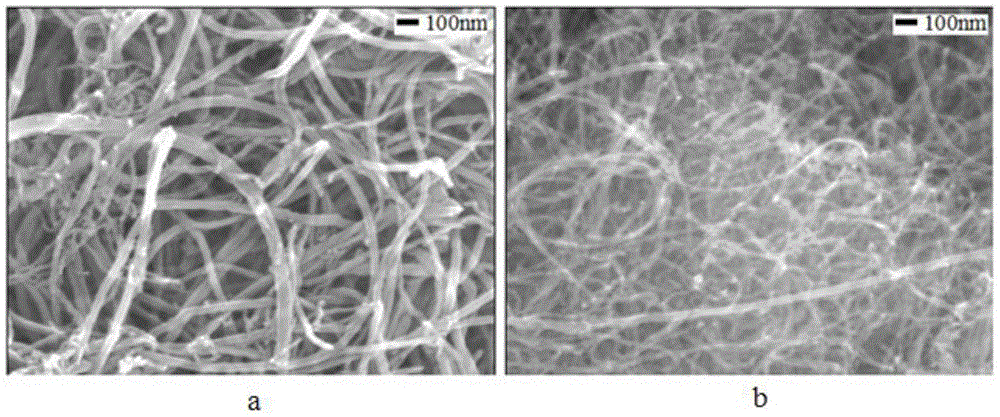A kind of carbon nanotube reinforced copper-based composite material and preparation method thereof
A copper-based composite material and carbon nanotube technology are applied in the carbon nanotube-reinforced copper-based composite material and its preparation, and in the field of copper-based composite materials, and can solve the safety hazards of tannic acid structure, large molecular weight, strong alkali, strong oxidant, Cumbersome process and other problems, to achieve the effect of improving electrical friction and wear performance, strength and impact resistance, good dispersion, and simple process
- Summary
- Abstract
- Description
- Claims
- Application Information
AI Technical Summary
Problems solved by technology
Method used
Image
Examples
Embodiment 1
[0041] Add multi-walled carbon nanotubes to 10mg / ml gallic acid aqueous solution, and disperse evenly, wherein the ratio of the weight of carbon nanotubes to the volume of gallic acid aqueous solution is 0.1g: 40ml; let it stand for 24h, filter, and take the filter residue at 60 and dried under vacuum for 2 h at °C to obtain surface-modified carbon nanotubes.
[0042] figure 1 Low magnification (×10000) SEM images of carbon nanotubes (CNTs) before and after treatment with aqueous gallic acid: a. SEM image without gallic acid aqueous solution treatment; b. SEM image after gallic acid aqueous solution treatment. figure 2 High magnification (×50000) SEM images of carbon nanotubes (CNTs) before and after treatment with gallic acid aqueous solution: a. SEM image without gallic acid aqueous solution treatment; b. SEM image after gallic acid aqueous solution treatment. from figure 1 with 2 It can be seen that the carbon nanotubes without gallic acid aqueous solution are agglomera...
Embodiment 2
[0046] Add single-walled carbon nanotubes to 3mg / ml gallic acid aqueous solution, and disperse evenly, wherein the ratio of the weight of carbon nanotubes to the volume of gallic acid aqueous solution is 0.5g: 60ml; let it stand for 12h, filter, and take the filter residue at 70 °C for 1 h in vacuum to obtain surface-modified carbon nanotubes.
[0047] Evenly disperse 0.1 g of the surface-modified carbon nanotubes prepared in this example in 100 ml of deionized water. After standing for 3 days, the precipitation gradually increases under the action of gravity, but the carbon nanotubes still maintain a dispersed state without occurrence of reunion. It shows that the surface-modified carbon nanotubes prepared in Example 2 have excellent dispersibility.
Embodiment 3
[0049] Add multi-walled carbon nanotubes to 18mg / ml gallic acid aqueous solution, and disperse evenly, wherein the ratio of the weight of carbon nanotubes to the volume of gallic acid aqueous solution is 0.05g: 20ml; stand for 30h, filter, and take the filter residue at 80 and dried under vacuum for 3 h at °C to obtain surface-modified carbon nanotubes.
[0050] Evenly disperse 0.1 g of the surface-modified carbon nanotubes prepared in this example in 100 ml of deionized water. After standing for 2 days, the precipitation gradually increases under the action of gravity, but the carbon nanotubes still maintain a dispersed state without occurrence of reunion. It shows that the surface-modified carbon nanotubes prepared in Example 2 have excellent dispersibility.
[0051] From Examples 1 to 3, it can be seen that the surface-modified carbon nanotubes prepared in Example 1 gradually precipitated under the action of gravity after standing for 5 days, and the carbon nanotubes were ...
PUM
| Property | Measurement | Unit |
|---|---|---|
| concentration | aaaaa | aaaaa |
| concentration | aaaaa | aaaaa |
| concentration | aaaaa | aaaaa |
Abstract
Description
Claims
Application Information
 Login to View More
Login to View More - R&D
- Intellectual Property
- Life Sciences
- Materials
- Tech Scout
- Unparalleled Data Quality
- Higher Quality Content
- 60% Fewer Hallucinations
Browse by: Latest US Patents, China's latest patents, Technical Efficacy Thesaurus, Application Domain, Technology Topic, Popular Technical Reports.
© 2025 PatSnap. All rights reserved.Legal|Privacy policy|Modern Slavery Act Transparency Statement|Sitemap|About US| Contact US: help@patsnap.com



